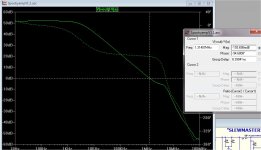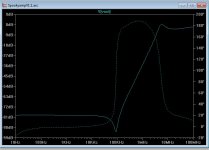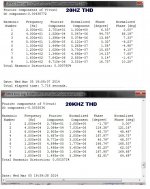Wait till I get "spooky" (and "symasui" - it's half finished) done ,AJ.
Then I take a break .... make some BOMS .. etc.
Thanx !
OS
ok just tell me when you are ready...you deserve a break....😀
I submit ... the "spooky" ....
I never understood why this topology has many fans ... now I know.
ALL this fuss about CFA superiority .... could it be just a case of
symmetry ?
First of all , this is a lowly VFA amp ..... not enough slew , but high
PSRR. So why do I get 200V/uS here ? Back to symmetry. The loop gain
plot is nearly identical to the CFA's (below 1) ... why ? As is a very high
gain margin at 20Khz , also like the CFA. 1.25mhz UG point , too .
PSRR is between a "blameless" and a CFA ... more like the current sourced
VSSA , but flatter (lower)- way down into LF ... (below 2).
Distortion is second only to the "blameless" (more like a VFA here - below 3).
I suspect this is why harmon/Kardon chose this as their top-of-the- line
receiver amp topology - this amp seems to combine the best traits of
both CFA AND VFA 😱 .
(below 3) at a 3R load at 2/3 power , it "smokes" all the other amps
, especially from 10HZ ! to 25K (7-15ppm) .. 🙂
PS - Professor leach added lead compensation to NFB to allow more
UG margin at a higher frequency ... use 2.7- 3.9p at the "LC" pads
on PCB ... Be sure to look over the package real well - print it out ...
Compare to schema ... (It's a 1.1 version) 😀
ENJOY !
OS
I never understood why this topology has many fans ... now I know.
ALL this fuss about CFA superiority .... could it be just a case of
symmetry ?
First of all , this is a lowly VFA amp ..... not enough slew , but high
PSRR. So why do I get 200V/uS here ? Back to symmetry. The loop gain
plot is nearly identical to the CFA's (below 1) ... why ? As is a very high
gain margin at 20Khz , also like the CFA. 1.25mhz UG point , too .
PSRR is between a "blameless" and a CFA ... more like the current sourced
VSSA , but flatter (lower)- way down into LF ... (below 2).
Distortion is second only to the "blameless" (more like a VFA here - below 3).
I suspect this is why harmon/Kardon chose this as their top-of-the- line
receiver amp topology - this amp seems to combine the best traits of
both CFA AND VFA 😱 .
(below 3) at a 3R load at 2/3 power , it "smokes" all the other amps
, especially from 10HZ ! to 25K (7-15ppm) .. 🙂
PS - Professor leach added lead compensation to NFB to allow more
UG margin at a higher frequency ... use 2.7- 3.9p at the "LC" pads
on PCB ... Be sure to look over the package real well - print it out ...
Compare to schema ... (It's a 1.1 version) 😀
ENJOY !
OS
Attachments
Last edited:
OS do you have a special file for DIYAamp.txt that is called out in the ASC of the Spooky?
I wish I could find the same energy source you are running on right now, you have been prolific in both Output and Excellence in Engineering, like the sports analogy of in the ZONE...


 Thanks.
Thanks.
I asked once before, how many "minutes" of toner ironing do you do to make one of your masterpieces? 😀
I wish I could find the same energy source you are running on right now, you have been prolific in both Output and Excellence in Engineering, like the sports analogy of in the ZONE...



 Thanks.
Thanks. I asked once before, how many "minutes" of toner ironing do you do to make one of your masterpieces? 😀
OS do you have a special file for DIYAamp.txt that is called out in the ASC of the Spooky?
I wish I could find the same energy source you are running on right now, you have been prolific in both Output and Excellence in Engineering, like the sports analogy of in the ZONE...Thanks.
I asked once before, how many "minutes" of toner ironing do you do to make one of your masterpieces? 😀
I think " . include slewmaster.txt and .include DIYAamp.txt are included
in the comments.The .ASC should try to reference either of them.
I should just add the models right on the asc.
Energy source is Coffee !! 😀
I'll post diyatext ... my old models.
PS - not even a minute of ironing - hard flat surface and maybe 60 sec. on high (iron temp).
OS
Attachments
PS - not even a minute of ironing - hard flat surface and maybe 60 sec. on high (iron temp).
OS
OS you are using Southern Living pages. correct?
OS you are using Southern Living pages. correct?
Yep , with real southern clay content. 😀
PS - found a glitch on spooky ... R33/680K on the servo neg. pin 6 is un-labled. The copper/PCB
is freakin' perfect ... cool , I would say .. go for it.
OS
Last edited:
Yep , with real southern clay content. 😀
PS - found a glitch on spooky ... R33/680K on the servo neg. pin 6 is un-labled. The copper/PCB
is freakin' perfect ... cool , I would say .. go for it.
OS
found R22 (47k) unlabelled, connecting from anode (D4) to katode (D3) 🙂
Last edited:
found R22 (47k) unlabelled, connecting from anode (D4) to katode (D3) 🙂
Thank you , I think that's it ... Still have not found a copper error. PCB is
still "good to go".
Lots of parts on this one .. huh ?
How is your NAD-H ???
OS
still singing good, i love the bass compare to my SSA/VSSA build.Thank you , I think that's it ... Still have not found a copper error. PCB is
still "good to go".
Lots of parts on this one .. huh ?
How is your NAD-H ???
OS
if this Spooky sing beatifully i'll make Stereo amp with One channel NAD-H (CFA) and one channel Spooky (VFA)...😀
Last edited:
still singing good, i love the bass compare to my SSA/VSSA build.
if this Spooky sing beatifully i'll make Stereo amp with One channel NAD-H (CFA) and one channel Spooky (VFA)...😀
Cool !
You might not hear a difference , this VFA simulates very similar ...
except for slightly better servo performance - lower thd (especially LF)
This one also uses 18ma/per rail IPS current (more devices).
OS
So, OS which combo will it be?
Maybe we should vote on it ... some want CFA-X , some the NAD.
This new spooky might just blow the CFA's out of the water.
Rationally , only the wolverine/nad have been built-tested , as well as the
3-pair OPS.
I would go for the 3-pair OPS/NAD ... as discussed. Naf says "it sings"
(with killer bass - that kicks the VSSA's butt).
What do you think .. vote , or go ??
PS - I can always build "spooky's" later ... it is a modular design.
Edit - If it is the NAD , do you want me to through hole and eliminate the jumpers -
and other cosmetic tweaks ?
OS
Last edited:
OS,
This is where things start to get interesting. There is so much subjective information that does not follow with the measured THD numbers as we seem to approach the sub ppm values as you add more and more devices. Now we will have to have comparisons based on actual listening tests to determine if chasing lower and lower THD numbers are audible or not. I have a gut level feeling that there is an asymptotic point where the lower distortion values are decreasing in value and the question becomes at what point is that and do you lose something else in the music that we don't know to test for at the same time? As a speaker builder and knowing the percentage of distortion in a typical speaker I think that this just doesn't make sense at some point to keep going down that road, the speakers are going to more than swamp out the diminishing distortion numbers of the electronics at some point, where that point is is the question? This is one of the reasons that I am working so hard to lower the distortion on the speaker side, I think that is where the gold is hiding to get to the next level of reality.
This is where things start to get interesting. There is so much subjective information that does not follow with the measured THD numbers as we seem to approach the sub ppm values as you add more and more devices. Now we will have to have comparisons based on actual listening tests to determine if chasing lower and lower THD numbers are audible or not. I have a gut level feeling that there is an asymptotic point where the lower distortion values are decreasing in value and the question becomes at what point is that and do you lose something else in the music that we don't know to test for at the same time? As a speaker builder and knowing the percentage of distortion in a typical speaker I think that this just doesn't make sense at some point to keep going down that road, the speakers are going to more than swamp out the diminishing distortion numbers of the electronics at some point, where that point is is the question? This is one of the reasons that I am working so hard to lower the distortion on the speaker side, I think that is where the gold is hiding to get to the next level of reality.
I won't be subjective here.
It is not the low THD I am after here.
BUT , the low distortion does tell us some thing else. That the circuit is
not at "war" with itself. It also tells us that it will be stable into
many loads and is over designed.
THIS equates into a "industrial level" circuit that can stand up to decades
of use. This is why (even if it is simple and cool) ... I would not want the
VSSA/CFA-X as my primary amp. Too much riding on a single pair (the
current feedback + the input signal +the current sources).
At least the NAD splits the job between 2 stages and these stages can be
optimized. Also , a CFA circuit is a careful balance that NEEDS a Servo.
Servo's last 30-40 years ... never seen one blow ... mine have diode
protection as well.
All I want is real good sound that will be real loud/dynamic and last 20
years before recaps. 🙂
I agree with you , on mediocre loudspeakers .. these amps might sound
(just as bad) 😀 ... but on good high powered drivers I feel at least
a slight difference in sound stage/presentation would be noticed.
I'm primarily going for reliability - if one sounds better - so be it.
PS - NAF said it ... NAD has better bass ... the output stage is pushing
his drivers better with more control - the OPS is the game changer.
OS
It is not the low THD I am after here.
BUT , the low distortion does tell us some thing else. That the circuit is
not at "war" with itself. It also tells us that it will be stable into
many loads and is over designed.
THIS equates into a "industrial level" circuit that can stand up to decades
of use. This is why (even if it is simple and cool) ... I would not want the
VSSA/CFA-X as my primary amp. Too much riding on a single pair (the
current feedback + the input signal +the current sources).
At least the NAD splits the job between 2 stages and these stages can be
optimized. Also , a CFA circuit is a careful balance that NEEDS a Servo.
Servo's last 30-40 years ... never seen one blow ... mine have diode
protection as well.
All I want is real good sound that will be real loud/dynamic and last 20
years before recaps. 🙂
I agree with you , on mediocre loudspeakers .. these amps might sound
(just as bad) 😀 ... but on good high powered drivers I feel at least
a slight difference in sound stage/presentation would be noticed.
I'm primarily going for reliability - if one sounds better - so be it.
PS - NAF said it ... NAD has better bass ... the output stage is pushing
his drivers better with more control - the OPS is the game changer.
OS
Last edited:
OS,
Enough said. Quality and longevity are very important aspects of any design. I can appreciate that approach, I try and do the same thing, even if it means someone may think the design is overbuilt. I want to build something that will bring a smile to someone every time they turn it on, now just a few times and then on to the next thing. Let's see what the feelings are between the NAD and Spooky design. Those seem to be your best implementations of your input thoughts. As you say the output section has proven itself and should make a nice stable output section scalable to whatever power level you want within reason.
Enough said. Quality and longevity are very important aspects of any design. I can appreciate that approach, I try and do the same thing, even if it means someone may think the design is overbuilt. I want to build something that will bring a smile to someone every time they turn it on, now just a few times and then on to the next thing. Let's see what the feelings are between the NAD and Spooky design. Those seem to be your best implementations of your input thoughts. As you say the output section has proven itself and should make a nice stable output section scalable to whatever power level you want within reason.
My 105 watt triple EF3 HK amp can drive my speakers with just as much
authority as my larger EF2 amp. That is why I want a larger EF3.
If Meanman does the 3 pair , I will go all out and build a Semilab output
70V rail 200W amp with 100pf Cob (fast) sanken drivers .
I want fast and loud (for my output stage).
The OPS will have to "keep up" with whatever IPS I ultimately
settle on .
OS
authority as my larger EF2 amp. That is why I want a larger EF3.
If Meanman does the 3 pair , I will go all out and build a Semilab output
70V rail 200W amp with 100pf Cob (fast) sanken drivers .
I want fast and loud (for my output stage).
The OPS will have to "keep up" with whatever IPS I ultimately
settle on .
OS
Funny how my integrated HK with about 90 watts per channel outperforms my Parasound with 200 watts per channel. The Parasound has more output device, bigger heat sinks, bigger power supply and doesn't touch the HK in sound. I'm with you on implementation, it is obviously more than just having more power, it is also the sound quality of the components and the topology.
Funny how my integrated HK with about 90 watts per channel outperforms my Parasound with 200 watts per channel. The Parasound has more output device, bigger heat sinks, bigger power supply and doesn't touch the HK in sound. I'm with you on implementation, it is obviously more than just having more power, it is also the sound quality of the components and the topology.
in other forums, i used to say, i stopped counting watts a long time ago...
but you have to qualify your statement to be meaningful, like what was the speakers that you used, what was the sensitivity? did you use the same speakers to evaluate both? did you listen to them at the same volume level? using the same program material?
How can a lowly H/K touch the mighty Parasound ? , those amps are from
the "gods" 😀. They must sound better.
PS - most of the older HK's are VFA/"symasym" with EF3 Sanken output stages.
My comparison was on the same Mission speakers with the best Dayton replacement
drivers. using the same asus sound card. I can switch between amps.
OS
the "gods" 😀. They must sound better.
PS - most of the older HK's are VFA/"symasym" with EF3 Sanken output stages.
My comparison was on the same Mission speakers with the best Dayton replacement
drivers. using the same asus sound card. I can switch between amps.
OS
Last edited:
- Home
- Amplifiers
- Solid State
- Slewmaster - CFA vs. VFA "Rumble"


